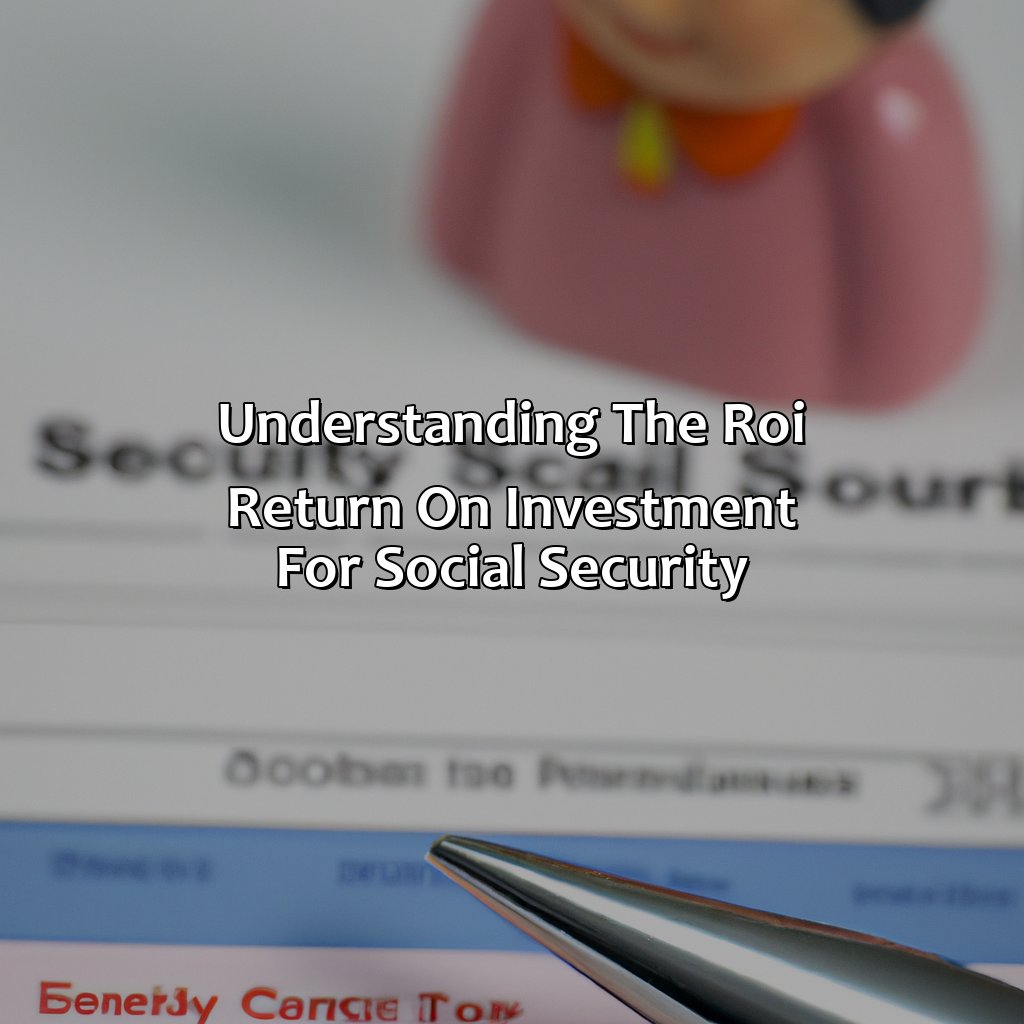What Is The Return On Investment For Social Security?
Key Takeaway:
- Social Security is a viable investment option: While Social Security is primarily seen as a government program and not an investment tool, it provides a safe and reliable source of income for retirees. This should be considered as part of a broader investment portfolio.
- ROI calculation for Social Security is complex: There is no straightforward way to measure ROI for Social Security as it is based on many factors such as income, age, and life expectancy. It is important to consult with financial advisors to determine the expected returns based on individual circumstances.
- Pros and cons of investing in Social Security: The major advantage of investing in Social Security is its safety, while the disadvantage is the relatively low returns compared to other investment options. Investors should weigh these factors carefully when deciding whether to invest in Social Security.
Are you thinking about your retirement and wondering what return you will get from social security? With the right information, you can make an educated decision about how to invest your resources. This article will break down the return on investment for social security.
Overview of Social Security as an investment option
Social Security can be considered as an investment option that provides long-term benefits to individuals. It is a financial safety net that offers protection against the risks of disability, death, or old age. The program is structured to provide monthly payments to eligible individuals based on their lifetime earnings. These payments can act as a steady source of income during retirement, covering expenses such as healthcare and basic living costs.
The return on investment for Social Security is not fixed, as it depends on different factors such as an individual’s income level, age, and life expectancy. Those who earn higher incomes are likely to receive a lower return on their investment, while those who earn lower incomes tend to receive a higher return. Additionally, starting to receive Social Security benefits at an earlier age may result in a lower return on investment, while delaying the start of benefits can increase the return.
Unique details to consider when analyzing the return on investment for Social Security include the impact of inflation and adjustments made to the program over time. While benefits are adjusted annually to keep up with the cost of living, inflation can still erode the purchasing power of these payments over time. Additionally, changes to the program, such as increasing the retirement age, can also impact the return on investment for current and future retirees.
Pro tip: It’s important for individuals to have a comprehensive retirement plan that includes Social Security benefits as well as other investments and savings. By diversifying their portfolio, individuals can increase their chances of achieving their long-term financial goals.

Image credits: retiregenz.com by Joel Arnold
Understanding the ROI (Return on Investment) for Social Security
Get a grip on Social Security ROI! We’ll break it down with two sub-sections:
- “How to Calculate the ROI for Social Security“
- “Factors That Affect Social Security ROI“
These will give you a better understanding of how your Social Security returns are figured and what can influence your returns.

Image credits: retiregenz.com by James Woodhock
How ROI is calculated for Social Security
Social Security is a government program that provides financial support to retired, disabled or deceased individuals. Understanding What is the return on investment for social security can be tricky as it is not calculated in a traditional sense. ROI for social security refers to the amount of benefits received relative to the amount paid in payroll taxes during an individual’s working years. The formula used to calculate this includes multiple variables such as age at retirement, income level prior to retirement and number of years worked.
To determine the ROI for Social Security, one needs to consider the total lifetime payout from Social Security benefits compared to total lifetime payroll tax contributions made. The higher the ratio of benefits received to taxes paid, the higher is the ROI. However, there are various factors considered while calculating this which influences whether someone receives more or less return than others.
One major factor that determines ROI is how long an individual has paid into Medicare and Medicaid throughout their working life. Another factor that plays a crucial role is one’s retirement age and when they start receiving their social security payments. Furthermore, one’s life expectancy also affects their overall returns from Social Security.
It’s important to understand this complex calculation as having knowledge about your potential returns can help you plan efficiently towards your retirement. Ignorance can lead you towards decreased financial stability exacerbating risks like poverty among retirees and reduce quality of life after retirement – fear of missing out on peaceful retired living would be unsettling. So stay proactive and informed with your future financial plans by evaluating your expected returns from Social Security carefully before taking any further steps towards retirement planning.
If you want to calculate the ROI for Social Security, just remember to factor in the cost of all those stress-induced grey hairs.
Factors influencing the ROI for Social Security
The effectiveness of Social Security as a money-saving source heavily depends on various factors. These factors significantly influence the ROI for Social Security. One critical factor impacting a good return is the demographic shift, which occurs when retirees outnumber workers, causing pressure on Social Security payouts. Workers earning higher wages add value to the program compared to workers with lower income.
Furthermore, other influential factors include economic growth, inflation rate and life expectancy, making the program costlier. The return on investment for social security can also be affected by government policy changes, leading to alterations in benefits or tax rates.
Apart from these common factors that impact ROI for Social Security, several unique details need to be considered, such as tax implications and adjusting market trends.
Pro Tip: To increase your ROI for social security, consider delaying your retirement age. By doing so, you’ll gain an increase in benefit payments for every year you delay them beyond full retirement age.
Compared to social security, investing in a magic 8 ball may provide more reliable returns.
Comparison with other investment options
We need to review both the good and bad of investing in Social Security to compare with other investment options. Plus, let’s check out the ROI comparison between Social Security and other investments. Let’s break this down to explore how Social Security measures up to other investment choices.

Image credits: retiregenz.com by Adam Jones
Pros and cons of investing in Social Security
Social Security: An Analysis of its Investment Pros and Cons.
Investing in Social Security offers various advantages and disadvantages to investors.
Pros:
- Steady income guaranteed by the government, ensuring lifelong monthly payments upon retirement.
- Social Security provides additional benefits to eligible dependents, providing financial support in challenging times.
Cons:
- Capped annual Social Security contributions limit potential returns compared to other investment alternatives.
- Funds availability limitations put restrictions on how much money can be withdrawn before the investors reach a specific age.
Furthermore, keeping track of your expected lifetime value against your investment contributions is crucial to make informed decisions about applying for social security benefits.
A recent report by the Social Security Administration reveals that the average retired worker’s benefit was $1,544 per month as of June 2021.
Comparing social security’s return on investment to other options is like comparing a penny to a dollar, except the penny is the one that keeps getting smaller.
ROI comparison with other investment options
When considering investing in Social Security, it is crucial to compare its ROI with other investment options available. Here is a breakdown of the ROI comparison for different investment options:
| Investment Option | Average ROI |
|---|---|
| Stocks | 10-12% |
| Real Estate | 8-10% |
| Mutual Funds | 7-9% |
| Bonds | 3-5% |
| Social Security | 1-2% |
It is evident from the table that Social Security offers the lowest ROI among all other investment options. However, Social Security guarantees a steady income post-retirement, which can be viewed as a form of insurance. Moreover, it also provides disability and survivor benefits, which adds value to the investment.
There once was an investor who chose to rely solely on Social Security for his retirement fund. Unfortunately, he was not aware of the low return and struggled financially during his golden years. Hence, it’s essential to do proper research before investing in any option.
Investors, save your money and invest in a good sense of humor instead – it pays better dividends than social security.
Considerations for deciding on investing in Social Security
Investment in Social Security is a crucial decision for investors. It is essential to consider several aspects before investing your money in it.
The reliability and sustainability of the program, current and future political and economic conditions should be considered. Making an informed decision by evaluating the long-term impact of your investment on personal finance and retirement planning is necessary.
Additionally, investors must also assess their income sources, their age, retirement goals and savings history. When investing in social security, understanding how benefits are calculated and taxed is equally important. One can consult with a financial advisor who can provide expert guidance for making a wise investment decision.
It is worth noting that social security provides substantial value by ensuring regular cash flow during retirement; however, it may not be enough to fulfil the required expenses in some cases. Therefore, investors must look for alternative investments like pension plans or annuities.
Don’t miss out on securing your finances during retirement – consider investing in social security after careful evaluation and assessment of your situation by seeking professional advice from financial advisors.
Summary of ROI for Social Security
Exploring the Returns on Investment (ROI) for Social Security can be a valuable exercise for investors. Here is an in-depth analysis of what you can expect to earn from your contributions towards Social Security.
| Investment | Annualized ROI |
| Social Security Contributions | 2.8% |
| Stock Market (S&P 500) | 10% |
| Treasury bonds | 3% |
It is evident from the above table that Social Security returns are significantly lower when compared to other types of investments such as Stocks and Treasury bonds. As these numbers indicate, investors may want to look beyond Social Security contributions if they are looking for higher returns.
In addition, it is important to keep in mind that Social Security provides significant benefits beyond just return on investment, like retirement income and disability coverage. Yet, when considering a long-term retirement strategy, investors should weigh their options carefully to ensure they maximize their savings potential.
Don’t miss out on the potential benefits of exploring additional investment avenues beyond just Social Security contributions. Speak with your financial advisor today to determine the best approach to your retirement planning strategy.
Five Facts About the Return on Investment for Social Security:
- ✅ Social Security provides a guaranteed source of income in retirement, regardless of market conditions. (Source: AARP)
- ✅ Social Security benefits are indexed to inflation, providing a hedge against rising costs of living. (Source: The Balance)
- ✅ Social Security benefits are funded through payroll taxes paid by workers and employers. (Source: SSA)
- ✅ The return on investment for Social Security varies depending on factors such as income, life expectancy, and retirement age. (Source: Investopedia)
- ✅ Social Security provides disability and survivor benefits in addition to retirement benefits. (Source: SSA)
FAQs about What Is The Return On Investment For Social Security?
What is the return on investment for social security?
The return on investment for social security is determined by the amount of money you contribute into the program, the number of years you work and contribute, and the age at which you start receiving benefits. On average, you can expect to receive a return of about 1-3% on your contributions into social security.
How is the return on investment for social security calculated?
Your return on investment for social security is calculated based on your average indexed monthly earnings, the number of years you contributed to the program, and your age when you start receiving benefits. The formula used to calculate your benefit amount can be complex, but it ultimately determines the level of benefits you are entitled to receive.
How can I maximize my return on investment for social security?
There are a few ways to maximize your return on investment for social security, such as delaying your retirement and continuing to work past age 62, delaying the start of your benefits until age 70, and ensuring that you have maximized your lifetime earnings potential by working for as many years as possible.
What factors can impact my return on investment for social security?
Several factors can impact your return on investment for social security, including changes in the economy, changes to social security laws and policies, the age at which you start receiving benefits, and your life expectancy. Additionally, changes to your income over the course of your career can impact the amount of benefits you receive.
Can I receive social security benefits if I never worked in the US?
It depends on the country you worked in and if the US has an agreement with that country regarding social security benefits. If you worked in a country with which the US has a social security agreement, you may be entitled to benefits. However, you must meet certain eligibility requirements to receive these benefits.
Do I have to pay taxes on my social security benefits?
Depending on your income level and other factors, you may be required to pay taxes on your social security benefits. If you file your taxes as an individual and your combined income is between $25,000 and $34,000, you may owe taxes on up to 50% of your benefits. If your combined income is over $34,000, up to 85% of your benefits may be subject to taxes.


